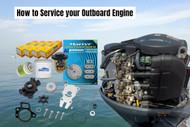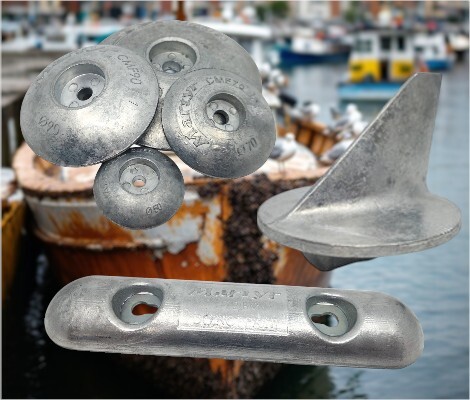How to Service Your Outboard Engine
15th Oct 2025
Regular servicing of your outboard engine is key to ensuring reliable performance and extending the life of your boat. Whether you’re a seasoned DIY enthusiast or prefer professional help, understanding the steps in outboard maintenance helps you keep your engine in tip-top shape.
Basic Outboard Engine Maintenance Steps
1. Flush the Engine After Every Use
Whether you boat in saltwater or freshwater, it's crucial to flush your engine after each trip. Running fresh water through the cooling system removes salt, dirt, and debris that can cause corrosion or blockages. Engines with built-in flushing ports make this easy by allowing hose attachment; if not, earmuff-style flushers are effective. Flush water for 5-10 minutes, following the engine manual's safe operating instructions.
2. Inspect and Clean the Propeller
Regularly check the propeller for any fishing line or debris wrapped around the shaft, as these can damage the seals. Inspect for dents or corrosion, and replace or repair the propeller if necessary. Maintaining the right propeller condition is essential for efficient propulsion and fuel economy.
3. Check Fuel Lines, Filters, and Primer Bulbs
Inspect fuel lines for cracks, brittleness or wear that could lead to leaks. Ensure the fuel primer bulb is soft, flexible, and damage-free. Replace fuel filters according to your owner’s manual, typically every 100 hours or annually, to maintain clean fuel flow and engine reliability.
4. Monitor and Replace Spark Plugs
Spark plugs ignite the fuel in your engine and are critical for smooth starts and running. Inspect plugs regularly and replace them approximately every 100 hours or sooner if the engine experiences rough starts or poor running. Clean or adjust spark plugs to correct minor performance issues.
5. Change Engine Oil and Gearcase Lubricants
For four-stroke engines, change marine engine oil and oil filters as per manual guidelines—usually every 100 hours or yearly. Additionally, check and replace gearcase (lower unit) lubricants to protect gears from wear and corrosion, vital for smooth transmission and propulsion.
6. Inspect and Replace the Water Pump Impeller
The impeller circulates cooling water through the engine. Inspect it annually or every 300 hours to avoid overheating. An impeller failure can lead to severe engine damage, so timely replacement is essential for engine health.
7. Lubricate Moving Parts and Apply Corrosion Protection
Use marine-grade grease to lubricate throttle and shift linkages, steering cables, and other moving parts. After freshwater or saltwater use, wipe down the engine and apply anti-corrosion sprays Quick-lube to exposed metal parts to prevent rust and prolong component life.
Additional Tips for Outboard Engine Care
- Use fresh, clean fuel: Always fill your tank with fresh, clean fuel to avoid contaminants that can clog your engine. Keep a fuel stabiliser on hand during storage periods to prevent fuel degradation and gum buildup in the fuel system.
- Store your outboard engine vertically: When storing your engine, position it vertically to allow water to drain completely and prevent internal corrosion or freezing damage, especially during offseason or long-term storage.
- Consult your manufacturer’s service manual: Always refer to the engine’s official service manual for model-specific maintenance instructions, recommended service intervals, and fuel and oil specifications.
When to Schedule Professional Servicing
Even if you perform routine maintenance yourself, it’s advisable to have your outboard engine professionally serviced at least once a year or every 100 operating hours, whichever occurs first. Professional technicians can conduct comprehensive inspections, perform necessary adjustments, replace worn parts, and execute diagnostic tests that require specialised tools or expertise. This ensures your engine runs efficiently and helps catch potential problems before they cause breakdowns.
Troubleshooting Common Issues
- Engine sputtering: Often caused by clogged fuel filters, dirty carburetors, or worn spark plugs, leading to uneven fuel delivery or ignition.
- Engine won’t start: Common issues include a dead battery, engaged kill switch, or fuel supply failure. Check these basics before moving to more complex diagnosis.
- Overheating: May result from blocked water intakes, malfunctioning water pumps, or impeller failure. Regular inspection and flushing of the cooling system can prevent overheating.
Carrying a basic toolkit and spare critical parts, such as spark plugs and fuel filters, on board can help manage minor issues swiftly on the water and avoid extended downtime.
Frequently Asked Questions (FAQs) About Outboard Engine Servicing
How often should I service my outboard engine?
It’s recommended to perform basic maintenance, like flushing and inspections, after every use and to schedule professional servicing annually or every 100 operating hours, whichever comes first.
What is the importance of flushing the outboard engine?
Flushing removes salt, sand, and other debris from the cooling system, preventing corrosion and blockages that can lead to overheating or engine failure.
How do I know when to replace the water pump impeller?
Inspect the impeller annually or after every 300 hours of operation. If you notice an engine overheating or reduced water flow, it may need replacement.
Can I service my outboard engine myself?
Many maintenance tasks can be done DIY with the right tools and knowledge. However, complex repairs and annual tune-ups are best handled by qualified marine technicians.
What type of fuel should I use in my outboard engine?
Always use fresh fuel recommended by your engine manufacturer and add fuel stabiliser if the engine will be stored for extended periods.
Why is it important to keep the propeller in good condition?
A damaged propeller reduces performance, fuel efficiency, and can cause damage to the engine shaft seals.
What should I do if my engine overheats while on the water?
Stop the boat safely, check the water intake for blockages, and ensure the water pump is functioning properly. Avoid running the engine if overheating persists.
How do I store my outboard engine for long periods?
Store it vertically, use fuel stabiliser, flush the engine thoroughly, lubricate moving parts, and follow the manufacturer’s storage guidelines.
What are common signs of fuel-related issues?
Rough idling, sputtering, difficulty starting, or sudden loss of power often indicate clogged fuel lines, filters, or old/stale fuel.
How can I prevent corrosion on my outboard engine?
Rinse with fresh water after saltwater use, apply protective sprays to metal parts, and lubricate moving components regularly.

 Australian Dollars
Australian Dollars


